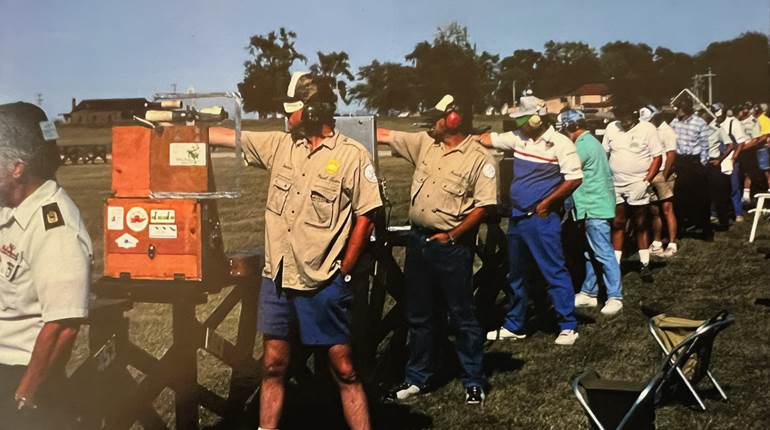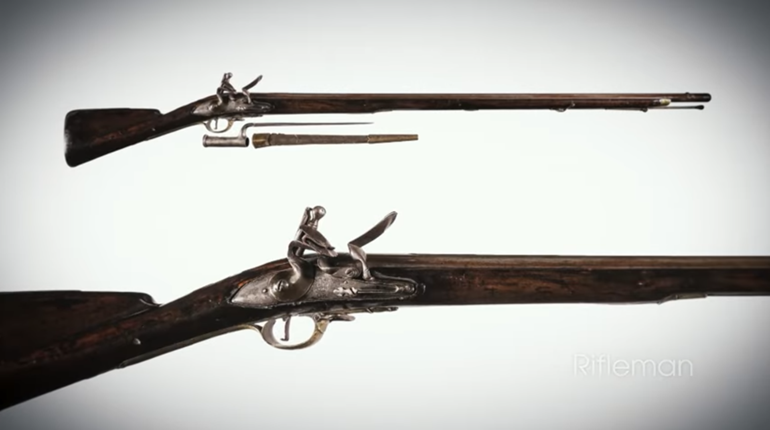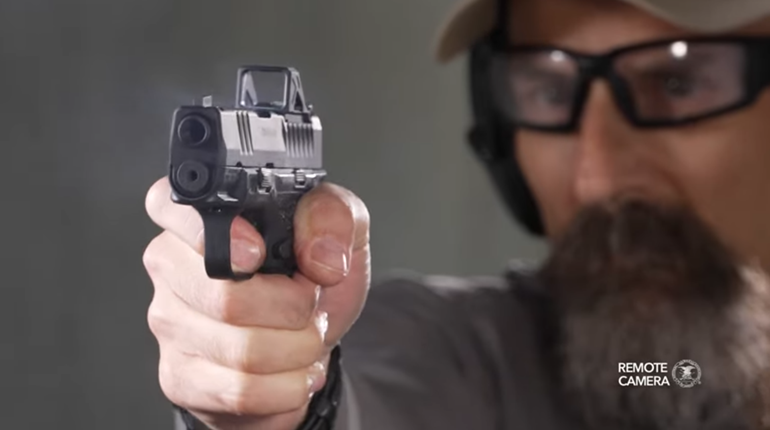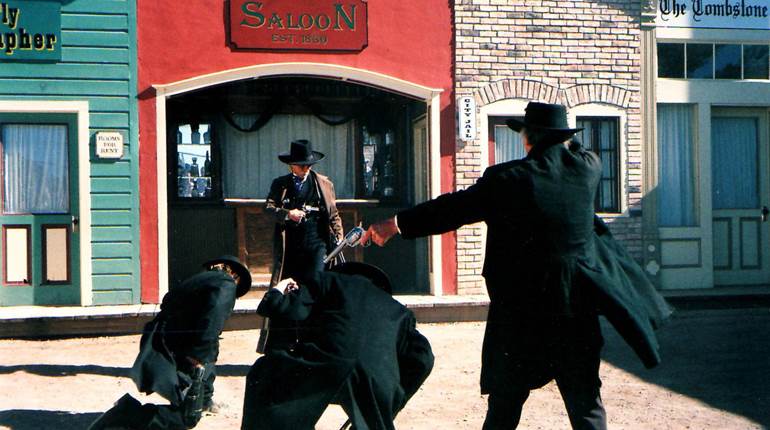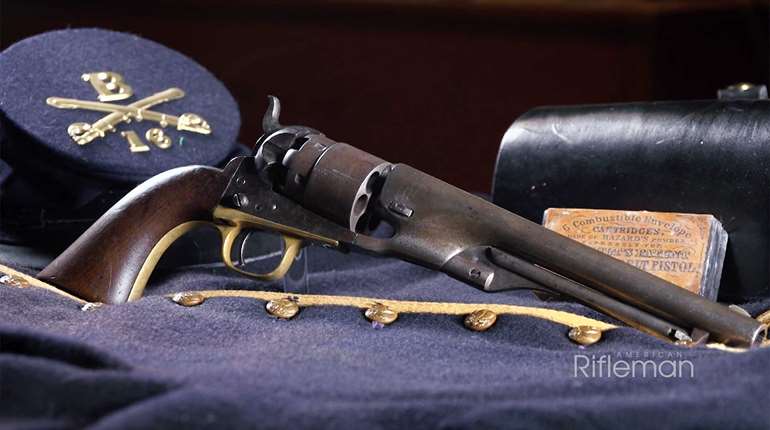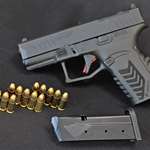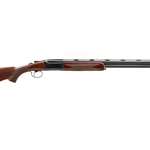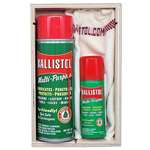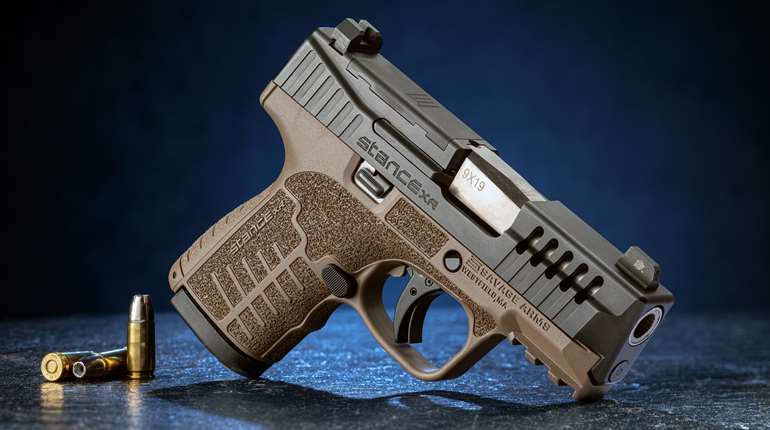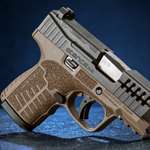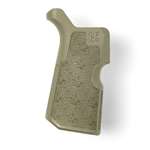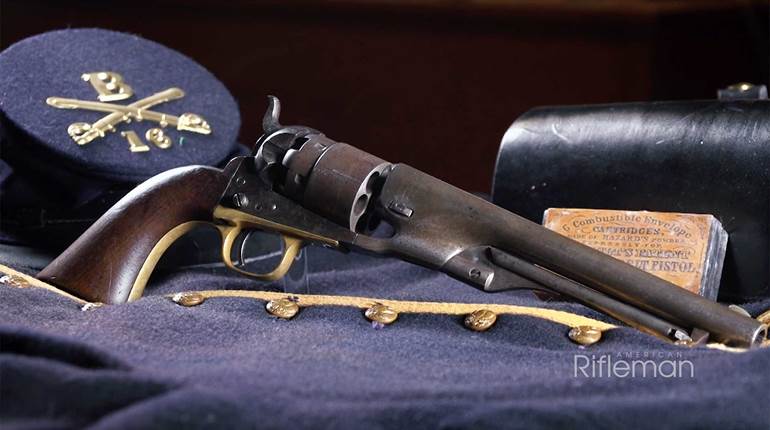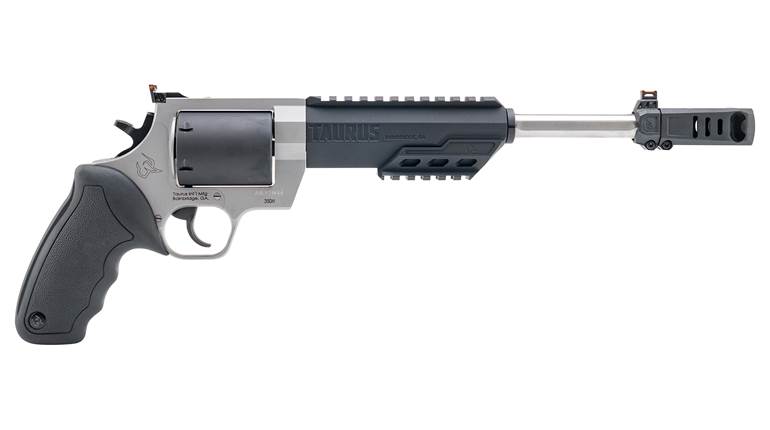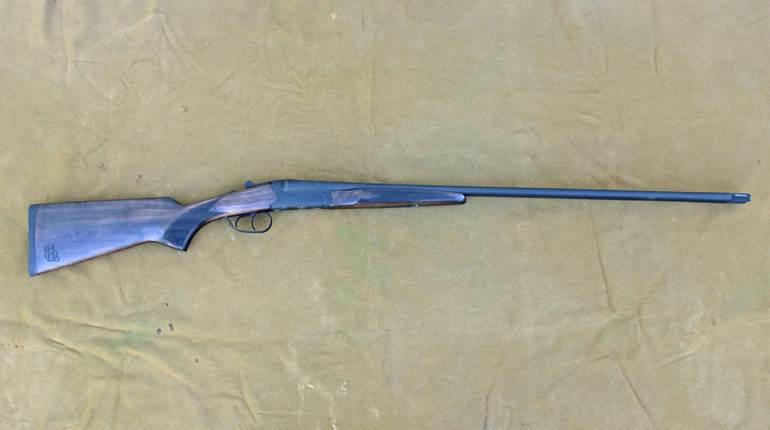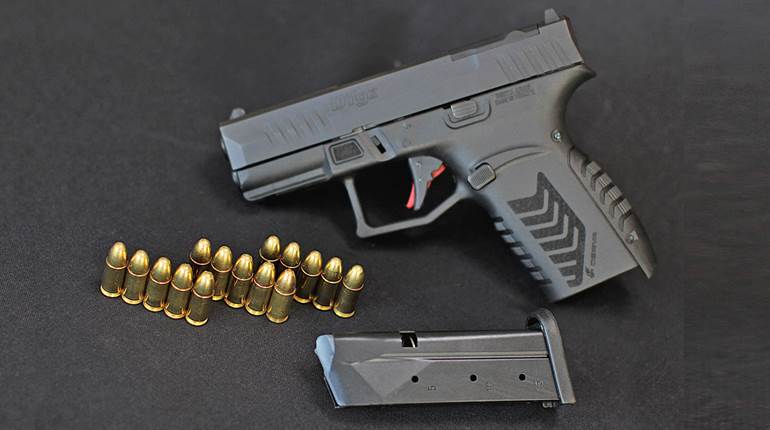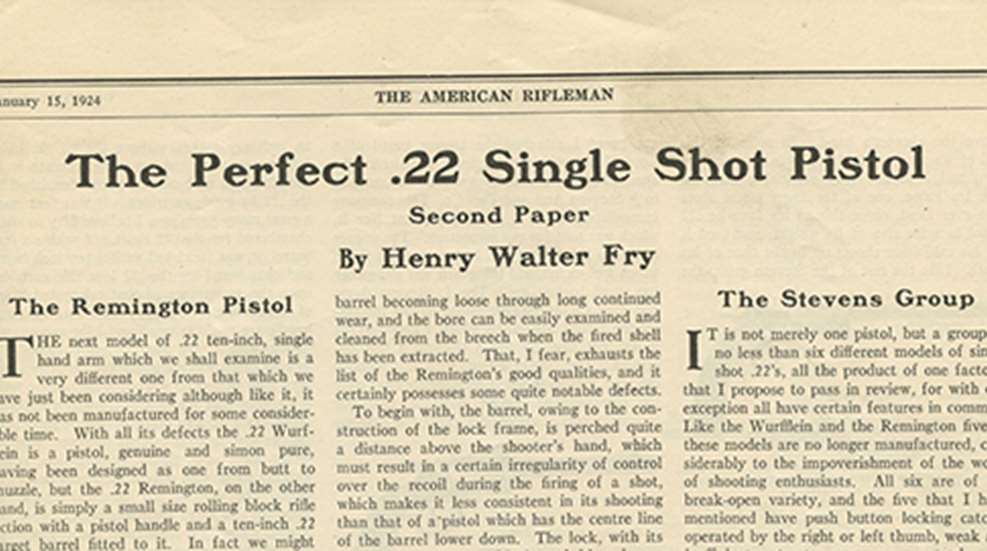
By Henry Walter Fry
The Remington Pistol
The next model of .22 ten-inch, single hand arm which we shall examine is a very different one from that which we have just been considering although like it, it has not been manufactured for some considerable time. With all its defects the .22 Wurfflein is a pistol, genuine and simon pure, having been designed as one from butt to muzzle, but the .22 Remington, on the other hand, is simply a small size rolling block rifle action with a pistol handle and a ten-inch .22 target barrel fitted to it. In fact we might call it a second degree makeshift, as the first barrels fitted to these arms were seven inch ones for a .50 caliber central fire cartridge, excellent for rough and tumble fighting at short range, so that it is not to be wondered at that the attempt to convert them into high-class delicate weapons of precision for super-accurate target shooting at fifty yards, by replacing the short big bore barrel with a long one of small caliber, did not succeed any better than it did.
But for all that there are some excellent points about the .22 Remington, one of the best being the fine, solid grip, fitting into the hand in every part, including the upper part between the thumb and first finger. In this it is in marked contrast with some more modern and supposedly up-to-date models which we shall examine later on. The shape of the lock frame sloping downwards to the rear above the trigger guard, combined with the position and set of the handle, not only brings the first finger easily on to the trigger when held in the firing position, but brings the rear outer curve of the trigger guard and frame into that position behind and below the trigger which allows the frame to be partly supported upon the second finger. In this point also the Remington is much superior to certain later models of other makes. The lock action is simple and strong, there is no possibility, always present in a break-open action, of the barrel becoming loose through long continued wear, and the bore can be easily examined and cleaned from the breech when the fired shell has been extracted. That, I fear, exhausts the list of the Remington's good qualities, and it certainly possesses some quite notable defects.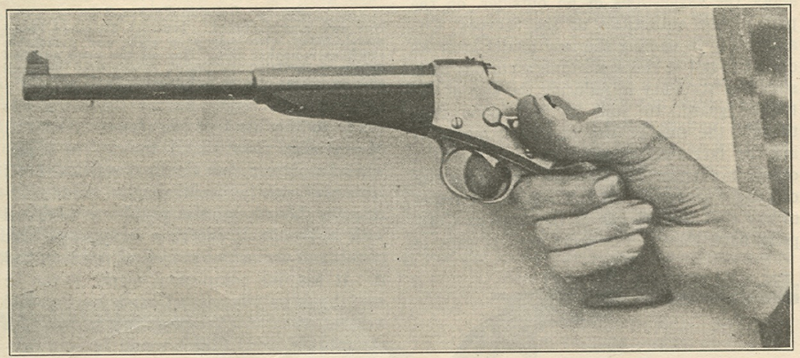 To begin with, the barrel, owing to the construction of the lock frame, is perched quite a distance above the shooter's hand, which must result in a certain irregularity of control over the recoil during the firing of a shot, which makes it less consistent in its shooting than that of a pistol which has the centre line of the barrel lower down. The lock, with its heavy rolling breech block and big, clumsy hammer, having been designed for a large caliber, powerful cartridge, is quite unnecessarily solid and substantial for the tiny rimfire shell, while the flat rifle trigger and feeble extracting action are two more points which militate against its inclusion in the Perfection class. But the feature which must have been the greatest handicap against its general adoption by the pistol marksmen of its day, is the excessively heavy barrel.
To begin with, the barrel, owing to the construction of the lock frame, is perched quite a distance above the shooter's hand, which must result in a certain irregularity of control over the recoil during the firing of a shot, which makes it less consistent in its shooting than that of a pistol which has the centre line of the barrel lower down. The lock, with its heavy rolling breech block and big, clumsy hammer, having been designed for a large caliber, powerful cartridge, is quite unnecessarily solid and substantial for the tiny rimfire shell, while the flat rifle trigger and feeble extracting action are two more points which militate against its inclusion in the Perfection class. But the feature which must have been the greatest handicap against its general adoption by the pistol marksmen of its day, is the excessively heavy barrel.
With singular lack of that rare quality of mind which I should call the intuitive perception of the essentials of things, the makers of the .22 Remington, like the maker of the .22 Wurfflein, committed the blunder of having one size barrel only for all calibers up to .44. In this the weight and balance of the ten inch Remington are absolutely perfect, but its weight in .22 caliber, about 2 3/4 pounds, makes it quite unsuitable for any but those of abnormal strength in the arms and shoulders. This, of course, may be obviated by having sufficient metal turned off the outside of the barrel and cut away from the rolling block and hammer to bring it down to what I should describe as a usable weight in the way that was done to one of these pistols which came under my notice a year or two ago, but even then the other defects that I have mentioned would put the .22 Remington in a place quite a distance from the Perfect .22 Single Shot Pistol.
The Stevens Group
It is not merely one pistol, but a group of no less than six different models of single shot .22s, all the product of one factory, that I propose to pass in review, for with one exception all have certain features in common. Like the Wurfflein and the Remington five of these models are no longer manufactured, considerably to the impoverishment of the world of shooting enthusiasts. All six are of the break-open variety, and the five that I have mentioned have push button locking catches operated by the right or left thumb, weak and inefficient extractors, very accurate barrels, small and light lock work of rather poor material and finish, and handles, which, though rather small, especially in the upper part, are of excellent design, and in most of them the curve into the frame outside the rear of the trigger guard is in the right position for the second finger to give partial support to the weight of the pistol when taking aim. In most of them, too, the barrel line is low down in the hand, which, as my readers will remember, is one of the essential points that I have specified for .22 single shot pistol perfection.
There is not the same uniformity in their triggers, one model being fitted with a trigger of an entirely different design from those of the others, so these will be described separately.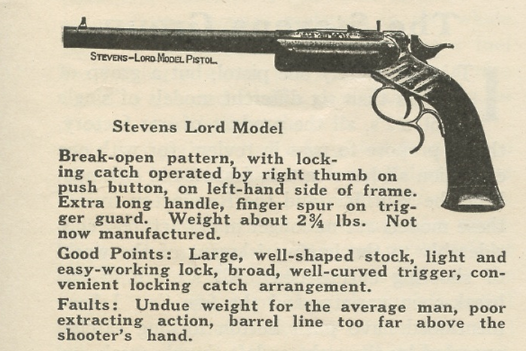
The largest and heaviest of the group was the Lord model, so called, not on account of any aristocratic or religious inclinations on the part of its makers, but, according to Mr. A. C. Gould in his book, "Modern American Pistols and Revolver," from Mr. Thomas Lord, at one time a celebrated pistol shot and proprietor of a shooting gallery in New York City, and who is likewise described by Mr. Gould as being "of a herculean frame." As he was the constant user of the pistol which was named after him, he needed to have been, as it weighed three pounds with the 12-inch .22 caliber barrel with which it was sometimes furnished, essentially a strong man's gun. The lock was very smooth and rounded with a tolerable curve to it. The grip, evidently designed for a big man's hand, was very long, with a finger spur on the under side of the trigger guard to accommodate the second finger and give additional firmness to the hold, somewhat necessary, as the barrel line is a rather long way above the shooter's hand. In spite of this and of its weak extractor it was an excellent arm, and it is not very surprising that the late Ira Paine, one of the finest pistol shots who ever lived, chose this as his favorite .22 pistol in spite also of its weight, and used it for his exhibition shoots up to the time of his death. Like the rest of the Stevens group the Lord Model has the merit of independent design as a pistol, and is in no way an adaptation from any other arm.
The next two models, the Conlin and the Gould, were exactly alike except for one minor feature, so nearly similar that I feel almost justified in coining a compound word and calling them near-twins. They were built on similar lines to the Lord Model, but smaller, lighter and handier in every way for the average man, and of just the right weight, namely about 1 3/4 pounds. Their triggers were not good, being too flat and narrow, and their grips were a little too thin and small in the upper part, which is perhaps the reason why the makers put the spur for the second finger upon the Conlin Model, called after Mr. James S. Conlin, another shooting gallery proprietor in New York. The Gould Model was named after the late A.C. Gould, a well-known rifle shot, author of shooting books and editor of "Shooting and Fishing," the successor to "The Rifle," and predecessor of "Arms and the Man" and the present "Rifleman's Magazine." The story of the designing of the Gould and Conlin Models is best told in Mr. Gould's own words, taken from his book, "Modern American Pistols and Revolvers."
"The model (Conlin) former had the side covered trigger, which was never liked by the 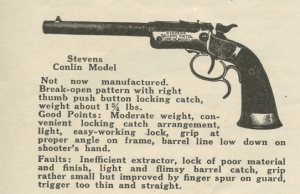 writer …. I found the Lord Model too have for me to hold steadily, the Conlin Model was objected to on account of the side covered trigger; therefore I attempted to alter a pistol to better suit me. I procured a Conlin Model frame. Cutting off the side trigger guard I attached the trigger guard of a Lord Model pistol; and when I had altered the arm to better suit me, I forwarded the same to J. Stevens Arm and Tool Co. This company immediately made a pistol somewhat like it, which was sent for my inspection. The trigger guard to the new pistol had a spur on it, to which I objected, and the guard was altogether too small to suit me. The J. Stevens Arms and Tool Co. asked permission to call the pistol the Gould Model, to which I objected, as it was not like the one I thought I had improved. The trigger guard, with and without the spur, was so much of an improvement over the side covered trigger, however, that the manufacturers abandoned making the original Conlin Model, and called the one without the spur the Gould Model, and with the spur the Conlin Model."
writer …. I found the Lord Model too have for me to hold steadily, the Conlin Model was objected to on account of the side covered trigger; therefore I attempted to alter a pistol to better suit me. I procured a Conlin Model frame. Cutting off the side trigger guard I attached the trigger guard of a Lord Model pistol; and when I had altered the arm to better suit me, I forwarded the same to J. Stevens Arm and Tool Co. This company immediately made a pistol somewhat like it, which was sent for my inspection. The trigger guard to the new pistol had a spur on it, to which I objected, and the guard was altogether too small to suit me. The J. Stevens Arms and Tool Co. asked permission to call the pistol the Gould Model, to which I objected, as it was not like the one I thought I had improved. The trigger guard, with and without the spur, was so much of an improvement over the side covered trigger, however, that the manufacturers abandoned making the original Conlin Model, and called the one without the spur the Gould Model, and with the spur the Conlin Model."
This little story is interesting in more ways than one. It reveals a praiseworthy readiness,  not very often found in arms companies, to adopt the suggestions of an outsider, on the part of the authorities of the Stevens Co., a courtesy in naming the new model after its designer, and at the same time a curious little streak of stupidity in reducing the size of the trigger guard, to suit, as no doubt they thought the smaller size of pistol, overlooking the fact that human fingers, being of a constant average size, require the same size of trigger guard for all size pistols. I regret to say that the officials of the Stevens Company have shown even more serious gaps in their intelligence than this, as I shall show later.
not very often found in arms companies, to adopt the suggestions of an outsider, on the part of the authorities of the Stevens Co., a courtesy in naming the new model after its designer, and at the same time a curious little streak of stupidity in reducing the size of the trigger guard, to suit, as no doubt they thought the smaller size of pistol, overlooking the fact that human fingers, being of a constant average size, require the same size of trigger guard for all size pistols. I regret to say that the officials of the Stevens Company have shown even more serious gaps in their intelligence than this, as I shall show later.
The Gould and Conlin models had another point of superiority over the Lord model in that their barrel lines were closer down to the hand when grasped in the firing position.
The next model in the grow of five which have disappeared from the open market is, I 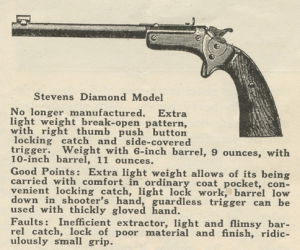 believe, the oldest of them all and one which stands in a class quite by itself, that of the extra light weight single shot pistol, so light that it could be carried in an inside pocket of an ordinary jacket without the weight being felt in any way, and yet very accurate in its shooting and with all the power furnished by the .22 long-rifle cartridge. It was first made a great many years ago, I believe fifty or sixty, chambered for the .22 short and with six inch barrel, it was furnished with a ten inch barrel and chambered for the .22 long-rifle cartridge upon the appearance of that celebrated brand of ammunition. Barrel, frame, clockwork and handle are made as small and light as was consistent with safety and efficiency, indeed the locking catch was made smaller, as after a not very long period of wear it would often work quite loose and frequently allow the pistol to break open at the firing of every shot. All the Stevens locking catches however, were of rather light and flimsy construction, often working loose with only a moderate period of wear. The lines of the Diamond model, the name of this extra light weight .22, were excellent, as will be seen from the illustrational the bold downward sweeping curve past the trigger to the butt of the grip brought the recess for the second finger into just the right position, and the center line of the barrel was closer to the hand of the shooter than that of any other pistol that I know. The trigger was of a pattern now almost obsolete and if I remember rightly the Remington double derringer is the only modern pistol now furnished with it, though at one time many single shot pistols and one or two models of revolvers had it. It has one conspicuous merit: it can be used by a heavily gloved hand in very cold weather when an attempt to use an arm with the usual guarded trigger would be both difficult and dangerous.
believe, the oldest of them all and one which stands in a class quite by itself, that of the extra light weight single shot pistol, so light that it could be carried in an inside pocket of an ordinary jacket without the weight being felt in any way, and yet very accurate in its shooting and with all the power furnished by the .22 long-rifle cartridge. It was first made a great many years ago, I believe fifty or sixty, chambered for the .22 short and with six inch barrel, it was furnished with a ten inch barrel and chambered for the .22 long-rifle cartridge upon the appearance of that celebrated brand of ammunition. Barrel, frame, clockwork and handle are made as small and light as was consistent with safety and efficiency, indeed the locking catch was made smaller, as after a not very long period of wear it would often work quite loose and frequently allow the pistol to break open at the firing of every shot. All the Stevens locking catches however, were of rather light and flimsy construction, often working loose with only a moderate period of wear. The lines of the Diamond model, the name of this extra light weight .22, were excellent, as will be seen from the illustrational the bold downward sweeping curve past the trigger to the butt of the grip brought the recess for the second finger into just the right position, and the center line of the barrel was closer to the hand of the shooter than that of any other pistol that I know. The trigger was of a pattern now almost obsolete and if I remember rightly the Remington double derringer is the only modern pistol now furnished with it, though at one time many single shot pistols and one or two models of revolvers had it. It has one conspicuous merit: it can be used by a heavily gloved hand in very cold weather when an attempt to use an arm with the usual guarded trigger would be both difficult and dangerous.
In the Diamond model handle the reduction in size was carried to a perfectly ridiculous length, the designers, as in the planning of the guard for the Gould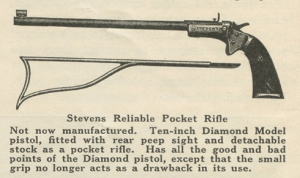 and Conlin models, being seemingly unaware that the dimensions of the human hand are a constant, and that the handle of a pistol should be a constant as well. Instead of which they made a handle about suitable to the hand of a five year old child instead of to that of a grown up man, by whom the pistol was meant to be used. I am not cognizant with their mental processes, of course, but they probably carried out of the reducing of the pistol parts without stopping to think whether it was warranted by the conditions under which it had to be used, and so made the handle small because all the other parts were small too, a singular instance of what I should call mental density.
and Conlin models, being seemingly unaware that the dimensions of the human hand are a constant, and that the handle of a pistol should be a constant as well. Instead of which they made a handle about suitable to the hand of a five year old child instead of to that of a grown up man, by whom the pistol was meant to be used. I am not cognizant with their mental processes, of course, but they probably carried out of the reducing of the pistol parts without stopping to think whether it was warranted by the conditions under which it had to be used, and so made the handle small because all the other parts were small too, a singular instance of what I should call mental density.
As turned out by the factory, the Diamond model pistols were made with two lengths of 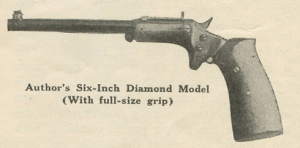 barrels, six-inch and ten-inch, the six-inch size weighing only nine ounces and the ten inch size eleven ounces, and both fitted with either peep or open sights. How the peep sight was intended to be used on either the six or ten inch barrels, without the aid of a shoulder stock I do not know, and I would not be at all surprised if the makers did not know either. Certainly they couldn't be used at arm's length, the peep was too small, and for a man to hold a six inch pistol close up against his countenance, which he would have to do to use the peep properly is quite an unthinkable proposition. That the makers were conscious of the fact that the peep sight needed a shoulder stock was shown by the fact that they did bring out some of the ten inch Diamond models with peep sights fitted with a detachable skeleton shoulder stock and called it the Reliable Pocket Rifle, a really excellent name as it was reliable in its shooting and it was a pocket rifle, that is to say, a rifle that could be carried in the pocket. Other models of so-called pocket rifles were too long and heavy to be carried in anything but a suitcase.
barrels, six-inch and ten-inch, the six-inch size weighing only nine ounces and the ten inch size eleven ounces, and both fitted with either peep or open sights. How the peep sight was intended to be used on either the six or ten inch barrels, without the aid of a shoulder stock I do not know, and I would not be at all surprised if the makers did not know either. Certainly they couldn't be used at arm's length, the peep was too small, and for a man to hold a six inch pistol close up against his countenance, which he would have to do to use the peep properly is quite an unthinkable proposition. That the makers were conscious of the fact that the peep sight needed a shoulder stock was shown by the fact that they did bring out some of the ten inch Diamond models with peep sights fitted with a detachable skeleton shoulder stock and called it the Reliable Pocket Rifle, a really excellent name as it was reliable in its shooting and it was a pocket rifle, that is to say, a rifle that could be carried in the pocket. Other models of so-called pocket rifles were too long and heavy to be carried in anything but a suitcase.
Not having been fortunate enough to find a Reliable Pocket Rifle as turned out by the 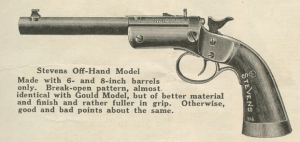 factory, I improvised one by fitting an ordinary ten inch Diamond model with special grip to which is attached a home made folding peep sight made from a brass desk hinge, and with a hole in the back to take the projecting spur of a home made detachable shoulder stock. The front sight is a Lyman Combination No. 5, the hooded pin head of which is used with the peep sight when the pistol is fired as a pocket rifle. For off-hand work the peep sight is folded back, the pin head is folded down and the open rear notch is used with the open ivory bead of the Combination Lyman.
factory, I improvised one by fitting an ordinary ten inch Diamond model with special grip to which is attached a home made folding peep sight made from a brass desk hinge, and with a hole in the back to take the projecting spur of a home made detachable shoulder stock. The front sight is a Lyman Combination No. 5, the hooded pin head of which is used with the peep sight when the pistol is fired as a pocket rifle. For off-hand work the peep sight is folded back, the pin head is folded down and the open rear notch is used with the open ivory bead of the Combination Lyman.
As turned out by the factory the Diamond pistols, and I have handled a good many of them, were often very crude affairs, with very hard trigger pulls and mainsprings so intolerably stiff that cocking the hammer a few times made the thumb quite sore. But all the same they had in them the makings of very fine little weapons. That a ten inch Diamond model is accurate I have myself proved with my six-point machine rest, from which one of them made two, one inch, ten shot groups, at fifty yards out of the six groups fired, and what has been done with one off-hand is shown by four groups made at fifty yards and reproduced in Mr. Gould's "Modern American Pistols and Revolvers," three showing nine out of ten shots in the 3 3/8 inch ten ring of the Standard American Target, and the fourth of gift shots with only two shots outside the eight-inch bullseye. What a man could do off-hand with the little nine-ounce six-inch Diamond model I do not know, but from my six-point rest I have made several 1 3/4-inch ten shot groups at fifty yards with the one that I am fortunate enough to be the owner of. The mainspring and trigger pull of this particular one have been eased down to usable strengths, the sights are a combination of big ivory front bead and big square cut rear notch, and, as shown in the illustration, it has been fitted with a man size walnut handle. Accurate, powerful and of feather weight, it makes the finest pocket companion for a hunting, fishing or camping trip that a man could possibly have, and fitted up as this one is, the ten-inch for the target and the six-inch for the woods, the Stevens Diamond model comes very near indeed to being the Perfect .22 Single Shot Pistol.
Some years ago, about the time when the Stevens Co. discontinued the making of the Lord, Conlin and Gould models, they put out a model almost exactly similar to the last named, and called it the No. 35 or Off-hand model. The illustration shows how little difference there was between it and the Gould model. It was made with six, eight and ten inch barrels, and a polished walnut handle, rather fuller in the grip, at least so it always seemed to me, than the Gould model. Otherwise there was practically no difference between them. Of moderate weight, well made, very accurate, and with a very tolerable grip, it was, not indeed perfection, the extractor was too weak and trigger a little too flat for that, but a most excellent arm notwithstanding, and one which I would readily own as the ten-inch one of another make which is my favorite for target work at the present time. So why in the name of reason and common sense the company should have seen fit to discard this very fine model and bring out the one that they make now, I cannot for the life of me imagine.
Barring the handle, which is shaped like that of a medium calibre automatic, the Stevens 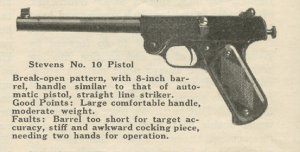 No. 10 single shot pistol has hardly anything to recommend it at all. Whether the makers intended it as a target pistol I do not know, for the barrel is only eight inches long. A very littlee reading of the right books, a very few inquiries among the members of the best pistol clubs would have taught them that no marksman of experience would so much as look at any target weapon with a barrel less than ten inches. Then they must have got into their heads the notion that there was some mystic value in a horizontally moving striker, though the hammers of their other models strike so nearly horizontal that the difference doesn't amount to anything at all. So instead of the smooth and easy working hammer, by which a pistol could be readily cocked with one hand, and to which from long years of use the shooters of the country had become thoroughly accustomed, they must needs go and put in an ugly, stiff working cocking piece, with a head so sharply milled that using it a few times makes a man's fingers quite sore, and which makes the cocking of the pistol an awkward double handed business in place of the quick, easy single handed action of the old form of trigger. There might have been some excuse for the new form of striker if it did really five any notable increase in accuracy, and I have a friend in the arms manufacturing business who believes that it does. I, on the other hand, am perfectly convinced that it doesn't amount to anything at all. I believe the materials and workmanship of the Stevens No. 10 to be good enough, but the finest finish in the world could never overcome, in the eyes of the shooters of experience and knowledge, the drawback of the short barrel, let alone the two handed cocking action in a weapon for the finest target accuracy.
No. 10 single shot pistol has hardly anything to recommend it at all. Whether the makers intended it as a target pistol I do not know, for the barrel is only eight inches long. A very littlee reading of the right books, a very few inquiries among the members of the best pistol clubs would have taught them that no marksman of experience would so much as look at any target weapon with a barrel less than ten inches. Then they must have got into their heads the notion that there was some mystic value in a horizontally moving striker, though the hammers of their other models strike so nearly horizontal that the difference doesn't amount to anything at all. So instead of the smooth and easy working hammer, by which a pistol could be readily cocked with one hand, and to which from long years of use the shooters of the country had become thoroughly accustomed, they must needs go and put in an ugly, stiff working cocking piece, with a head so sharply milled that using it a few times makes a man's fingers quite sore, and which makes the cocking of the pistol an awkward double handed business in place of the quick, easy single handed action of the old form of trigger. There might have been some excuse for the new form of striker if it did really five any notable increase in accuracy, and I have a friend in the arms manufacturing business who believes that it does. I, on the other hand, am perfectly convinced that it doesn't amount to anything at all. I believe the materials and workmanship of the Stevens No. 10 to be good enough, but the finest finish in the world could never overcome, in the eyes of the shooters of experience and knowledge, the drawback of the short barrel, let alone the two handed cocking action in a weapon for the finest target accuracy.
As I said before, the makers' reasons for putting the No. 10 pistol upon the market in place of the No. 35 or Off-hand model, discarding the good in favor of the bad, are to me a mystery, one of those things that, in the words of that celebrated philosopher Lord Dundreary "no feller can understand."
If only the makers would see fit to relegate the No. 10 to tis right and proper place, the junk pile, and give back to us the ten inch Off-hand model, they would not only be doing themselves a service from the increased sales that would certainly result from their action, but would confer a signal benefit on and earn the hearty approval of all the pistol enthusiasts of the country.
However, they say Every cloud has its silver lining. I have recently learned that the Stevens' Company have decided to reissue the Off-hand model. This will be welcome news to the pistol target shooters as the weapon will doubtless sell for the reasonable price for which all Stevens' arms are famed and in accuracy it should have no superior. They are, however, re-issuing it six- and eight-inch barrels only.
Readers of the old "Shooting and Fishing" of the early '90s well remember the time when the pages of that publication were filled with the marvelous records and performances of the many Stevens' target pistols and now that they have placed this Off-Hand model back on the market we may again look for the Stevens' products to be heard from in the .22 caliber pistol shooting field.












